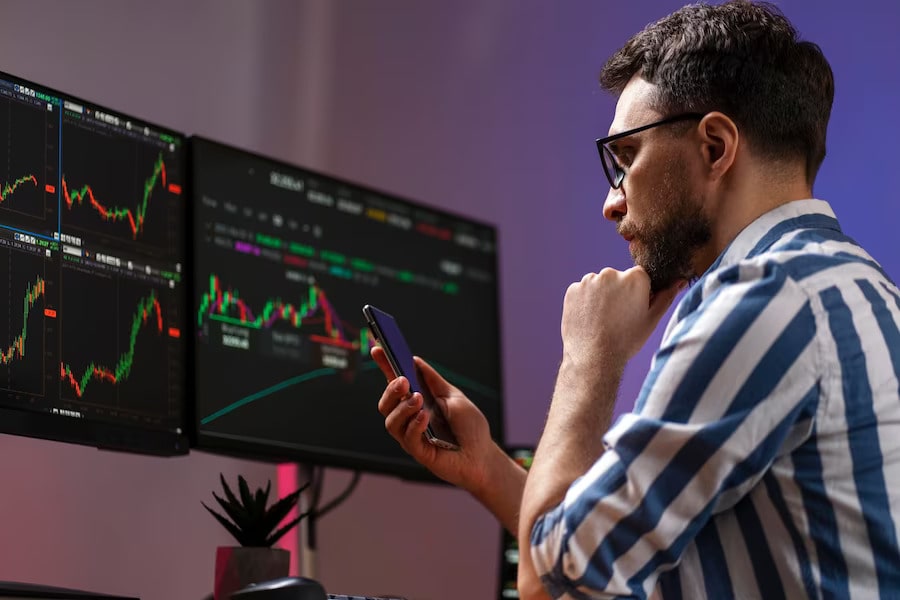Are you ready to venture into the dynamic world of Forex trading but unsure where to begin? Look no further! Our beginner-friendly Free Forex course is specifically designed to equip you with the knowledge and skills necessary to successfully operate in the Forex market. The best part? It’s completely free! Whether you’re a complete novice or have some trading experience, our Free Forex course will guide you through the fundamentals. The course includes everything from currency pairs to analyzing charts and implementing effective trading strategies. With expert instructors and interactive learning materials, you’ll establish a solid foundation and gain the upper hand. Don’t miss this opportunity to kickstart your Forex journey – join our free Forex course today and unlock the potential of the global financial markets.
Why Forex Trading is a Lucrative Investment Option?
Forex trading, also known as Foreign Exchange Trading, has gained increasing popularity due to its attractive investment opportunities. What sets Forex trading apart?
First and foremost, the Forex market is the largest and most liquid financial market globally. It has a daily trading volume surpassing $5 trillion. Such a large trading volume ensures ample opportunities for traders to enter and exit positions at any time.
Secondly, Forex trading offers the potential for substantial profits. Unlike other markets where traders usually profit from price appreciation, such as stocks or bonds, Forex trading allows traders to profit from both rising and falling markets. The ability to trade long and short positions enables you to capitalize on various market conditions and maximize potential returns.
Lastly, Forex trading provides flexibility in terms of trading hours. The Forex market operates 24 hours a day, five days a week. It allows you to participate at your convenience. This flexibility is especially advantageous for individuals with busy schedules.
In conclusion, Forex trading boasts several advantages that make it an appealing investment option. The market’s size and liquidity, the potential for profits in both rising and falling markets, and the flexibility of trading hours all contribute to its allure.
Mastering the Basics of Forex Trading With Our Free Forex Course
Before diving into Forex trading, it’s crucial to grasp the fundamentals. Forex trading involves buying and selling currency pairs with the aim of profiting from their exchange rate fluctuations.
Currency pairs are quoted in pairs like EUR/USD or GBP/JPY. The first currency in the pair is the base currency, while the second is the quote currency. The exchange rate represents the value of the base currency in relation to the quote currency.
To engage in Forex trading, you need to open a trading account with a reputable broker, which serves as your gateway to the market. This account allows you to execute trades and monitor your positions. It’s essential to select a broker offering competitive spreads, reliable trading platforms, and excellent customer support.
Once you have a trading account, you can begin analyzing the Forex market. Technical analysis refers to the study of historical price charts and using various indicators to predict future price movements. It is a commonly used approach to analyze the Forex market. On the other hand, fundamental analysis refers to the analysis of economic and political factors that impact currency values.
In summary, understanding the basics of Forex trading is essential before venturing into the Forex market. You must familiarize yourself with basic concepts of Forex trading, learn technical and fundamental analysis and then start trading.
Essential Forex Trading Terms and Concepts
Like any specialized field, Forex trading comes with its own set of terms and concepts. Here are some commonly used terms and concepts including various order types you should familiarize yourself with:
Pip
A pip is the smallest unit of measurement in Forex trading. It represents the fourth decimal place in most currency pairs. For example, if the EUR/USD exchange rate moves from 1.1000 to 1.1001, it’s an increase of one pip.
Leverage
Leverage enables traders to control larger positions with a smaller amount of capital. It is expressed as a ratio, such as 1:100. For instance, with leverage of 1:100, you can control a position worth $100,000 using only $1,000 of capital.
Stop Loss
A stop-loss order is used to automatically close a position at a predetermined price level. It is mainly used to limit potential losses if the market moves against you.
Take Profit
A take-profit order is the opposite of a stop-loss order. It automatically closes a position in profit at a predetermined price level.
Margin
Margin refers to the amount of money required to open and maintain a trading position. It represents a portion of the total position value that you need to provide as collateral.
Learning these terms and concepts will help you better understand Forex trading. So take your time to familiarize yourself with them and ensure you have a solid understanding before executing any trades.
Benefits of Starting with a Free Forex Course
Starting your Forex trading journey with a free Forex course can offer several advantages. Here are the benefits you can expect:
Comprehensive Learning Materials
Free Forex courses provide a wide range of learning materials. These courses may include video tutorials, e-books, and interactive quizzes. These resources will give you a solid understanding of the fundamentals of Forex trading.
Expert Instructors
Free Forex courses are often taught by experienced instructors who possess extensive knowledge of the industry. Their expertise and insights can guide you and help you avoid common mistakes.
Interactive Learning
Many free Forex courses offer interactive learning experiences where you can practice what you’ve learned in a risk-free environment. This approach accelerates learning and helps you develop practical skills.
Cost-effective
As the name suggests, free Forex courses come at no cost to you. This makes them a cost-effective way to learn the basics of Forex trading without a significant upfront investment.
By starting with a free Forex course, you can gain a solid understanding of the market. You will develop essential skills, and also determine if Forex trading is the right for you. It’s an excellent opportunity to explore Forex Market without any financial commitment.
What to Expect from Our Beginner-Friendly Free Forex Course
Our beginner-friendly Free Forex course is designed to provide you with a comprehensive understanding of Forex trading. Here’s an overview of what you can expect from our course:
Introduction to Forex
We will introduce you to the world of Forex trading. You will learn the market’s structure and understand the factors that influence currency prices.
Understanding Currency Pairs
Understanding currency pairs is crucial in Forex trading. We will explain how currency pairs are quoted. You will learn about major and minor currency pairs, and how to read currency quotes.
Analyzing Charts
Technical analysis is a vital skill for Forex traders. We will teach you how to read and interpret price charts, identify trends, and utilize various technical indicators to make informed trading decisions.
Implementing Trading Strategies
Developing a trading strategy is key to success in Forex trading. We will guide you through different strategies such as trend following, range trading, and breakout trading. We also help you to a choose strategy that suits your trading style.
Risk Management
Effective risk management is the most important part of Forex Trading. We will teach you to set stop-loss and take-profit levels. We also teach you to calculate position sizes and manage your overall risk exposure.
Using Trading Platforms
We will walk you through popular Forex trading platforms like MetaTrader 4. You will learn to execute trades, analyze charts, and monitor your positions.
By the end of our beginner-friendly Forex course, you will have a solid foundation in Forex trading. You will understand how the Forex market operates, analyze charts, implement trading strategies, and manage risk effectively. lastly, you will have enough confidence to start trading independently.
Setting Up a Forex Trading Account
To start trading Forex, follow these steps to set up a trading account with a reputable broker:
Research and Choose a Broker
Take the time to research different brokers and compare their offerings. Look for regulated brokers with competitive spreads, user-friendly trading platforms, and reliable customer support.
Complete the Registration Process
Visit the broker’s website and complete the registration process by providing your personal information, such as name, address, and contact details.
Verify Your Identity
Most brokers require identity verification, which involves providing a copy of your passport or driver’s license, as well as proof of address, like a utility bill or bank statement.
Fund Your Account
Once your identity is verified, you can fund your trading account. Brokers offer various funding options, including bank wire transfers, credit/debit cards, and online payment processors.
Download the Trading Platform
After funding your account, download and install the trading platform provided by your broker. MetaTrader 4 is a popular choice, offering a range of features and tools for Forex trading.
Practice on a Demo Account
Before trading with real money, practice on a demo account offered by most brokers. It allows you to trade with virtual funds in a simulated trading environment.
Following these steps will help you set up your Forex trading account and prepare for your trading journey.
The next part focuses on the various aspects of Forex trading, including technical analysis, developing a trading strategy, and risk management.
Learning Technical Analysis for Forex Trading
Technical analysis plays a significant role in Forex trading. It involves studying historical price charts and utilizing indicators to forecast future price movements. Here are essential concepts and tools commonly used in technical analysis:
Candlestick patterns
Candlestick patterns offer insights into market sentiment, indicating potential reversals or continuations in price trends. Examples include doji, hammer, and engulfing patterns.
Support and resistance levels
Support and resistance levels are price levels where the market tends to reverse or stall. Identifying these levels helps determine entry and exit points.
Trend lines
Trend lines help identify the direction of price trends. Drawing trend lines that connect higher lows or lower highs provides insights into the overall market direction.
Moving averages
Moving averages smooth out price data and identify trends. Commonly used moving averages are the simple moving average (SMA) and the exponential moving average (EMA).
Relative Strength Index (RSI)
The RSI or the Relative Strength Index is a momentum oscillator that measures the speed and change of price movements. It helps identify overbought or oversold conditions in the market.
Fibonacci retracement levels
Fibonacci retracement levels, based on Fibonacci ratios, indicate potential support or resistance levels. Traders use them to identify areas where prices may reverse or consolidate.
It’s important to note that technical analysis is not a foolproof method for predicting price movements. It should be used in conjunction with other forms of analysis, such as fundamental analysis.
Developing a Forex Trading Strategy
A well-defined trading strategy is essential for long-term success in Forex trading. Here are key steps to develop a solid trading strategy.
Define your trading goals
Clarify your objectives before developing a strategy. Determine whether you seek short-term gains or long-term wealth accumulation, as this will shape your approach.
Choose your trading style
Different trading styles, such as day trading, swing trading, or position trading, require distinct approaches and time commitments. Select the style that aligns with your goals and lifestyle.
Identify your risk tolerance
Assess your risk tolerance level. Some traders prefer high-risk trades for potentially higher returns, while others prioritize risk mitigation. Tailor your strategy accordingly.
Select your trading indicators
Choose indicators that align with your trading style and complement your analysis. Indicators help identify potential entry and exit points in the market.
Set risk management rules
Establish risk management parameters, including the risk per trade, maximum drawdown, and stop-loss levels. Adhere to these rules to protect your capital.
Backtest and refine your strategy
Test your strategy using historical data to evaluate its performance under different market conditions. Refine your strategy based on the results and continue the iterative process until you are satisfied.
Remember that no trading strategy guarantees profits. The Forex market is inherently unpredictable, and losses are part of trading. Staying disciplined, following your strategy, and continuously evaluating and adjusting it is crucial.
Risk Management in Forex Trading
Effective risk management is vital to safeguard your capital and ensure long-term profitability in Forex trading. Implement the following risk management techniques:
Set a risk per trade
Determine the maximum amount of capital you are willing to risk on each trade. This should be a percentage of your total trading capital, such as 1% or 2%, to protect against significant losses.
Use stop-loss orders
Always utilize stop-loss orders to limit potential losses. These orders automatically close a position at a predetermined price level, allowing you to exit a trade if the market moves against you.
Diversify your portfolio
Avoid concentrating all your trades on a single currency pair or asset class. Diversify across different pairs and classes to spread the risk and mitigate the impact of a single trade’s outcome.
Avoid overtrading
Overtrading often leads to emotional decision-making and impulsive trades. Stick to your trading strategy and avoid excessive trading, prioritizing quality trades over quantity.
Regularly evaluate and adjust
Continuously monitor your trading performance and reassess the effectiveness of your risk management strategies. Make necessary adjustments to improve your risk-reward ratio and overall risk exposure.
Stay informed
Keep yourself updated on market news, economic events, and developments that may affect the Forex market. Being aware of potential risks and volatility empowers you to make informed trading decisions.
Remember that risk management is an ongoing process that requires discipline and adherence to your predetermined rules. By effectively managing risk, you can protect your capital and increase the likelihood of long-term success in Forex trading.



